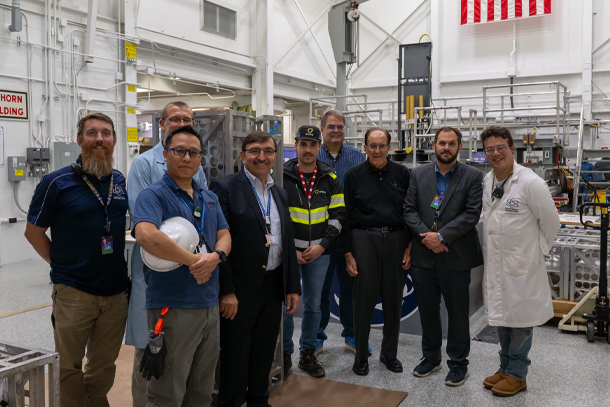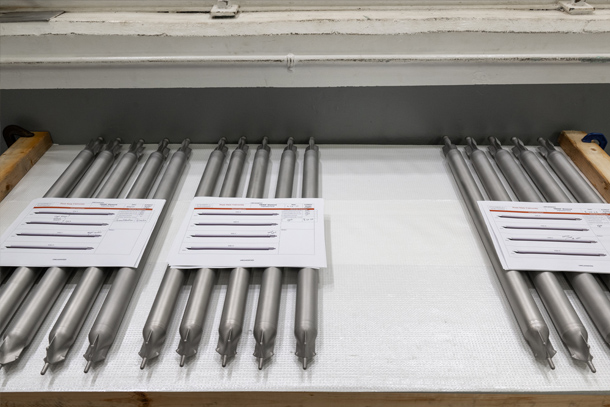
Pictured here, members of the Penn State Radiation Science and Engineering Center along with representatives from the U.S. Department of Energy, TRIGA International and Idaho National Laboratory. Credit: Kate Myers/Penn State
Penn State receives nation’s first TRIGA nuclear fuel delivery in a decade
September 28, 2023
By Tim Schley
UNIVERSITY PARK, Pa. — Penn State’s Radiation Science and Engineering Center (RSEC), home to the Breazeale Reactor, the nation’s longest continuously operating university research reactor, received the first new supply of Training, Research, Isotopes General Atomics (TRIGA) fuel shipped to the U.S. in more than a decade on Sept. 27.
The supply of thirty fuel elements that power the reactor are valued at $8.3 million, purchased by the U.S. Department of Energy (DOE) as part of a nine-year contract with TRIGA International, a joint venture between General Atomics and the France-based Framatome.
“Penn State’s nuclear research enterprise continues to grow in new and exciting ways, and this new fuel supports that growth,” said Andrew Read, interim vice president for research at Penn State. “Through significant investments to the reactor that now allow simultaneous neutron beam operations, as well as a partnership through the Nuclear Science User Facilities program, the University is uniquely positioned to make significant advances in nuclear science, share our knowledge and educate the next generation of nuclear engineers.”
TRIGA reactors — first conceptualized and brought to reality in the 1950s by a team that included famed physicists Edward Teller and Freeman Dyson — use a zirconium-hydride fuel that moderates the reactor’s temperature, meaning the nuclear reaction stops when the fuel reaches a certain temperature. TRIGA International, the world’s only supplier of the fuel, recently restarted its fuel production after a multi-year renovation project to its production facility in Romans, France.

The supply of 30 TRIGA fuel elements, valued at $8.3 million, was purchased by the U.S. Department of Energy, who manages all of the nuclear fuel provided to the nation's university operated reactors. Credit: Kate Myers/Penn State.
The Breazeale Reactor is one of 17 TRIGA reactors in operation in the U.S. Twelve of them are located at universities and are primarily used for training students, research projects and isotope production, which has applications in most economic sectors including medicine and food production. The DOE manages all of the nuclear fuel provided to the nation’s university-operated reactors through its University Fuel Services Program.
“This shipment of fuel represents DOE’s commitment to our university research reactors that are helping to train the future nuclear energy workforce,” said Kathryn Huff, DOE assistant secretary for nuclear energy in a corresponding release. “I’m also pleased to see this fuel support Penn State’s facility expansion and their new role as a Nuclear Science User Facilities partner helping to advance the nation’s nuclear R&D.”
At Penn State, advanced neutron imaging capabilities recently lent potential insight to the Amelia Earhart disappearance and the impact of microplastics distribution in the environment. Discoveries like these are poised to continue through recent upgrades to the reactor that expand its utilization, according to Kenan Ünlü, director of RSEC and professor of nuclear engineering. This includes the 2018 installation of five new beam ports — the tubes that connect the core to separate points of experimentation — and the 2022 expansion of a new neutron beam hall, which helped to make room for a soon-to-be-installed small angle neutron scattering (SANS) instrument. Once installed, the SANS instrument will be the only such university research reactor facility in the U.S., allowing researchers to measure how neutrons scatter when they interact with a variety sample materials, providing nanoscale details on their structures.
“It is certainly an exciting time for neutron science at Penn State, and the potential for discovery here is profound,” Ünlü said. “With RSEC’s recent expansion, the reactor will be available for more research than ever before. These new fuel elements will enable us to run the reactor for longer period of times to support studies conducted by Penn State faculty, students and collaborators at other universities and government agencies, building on the University’s long history as a leader in nuclear research and education and positioning RSEC as a premier nuclear destination in the nation.”
The mission of RSEC is to safely utilize nuclear technology to benefit society through education, research and service. The University is licensed to operate the Breazeale Reactor through the U.S. Nuclear Regulatory Commission. The NRC comprehensively inspects the reactor, including a review of fuel handling, on a two-year cycle.



